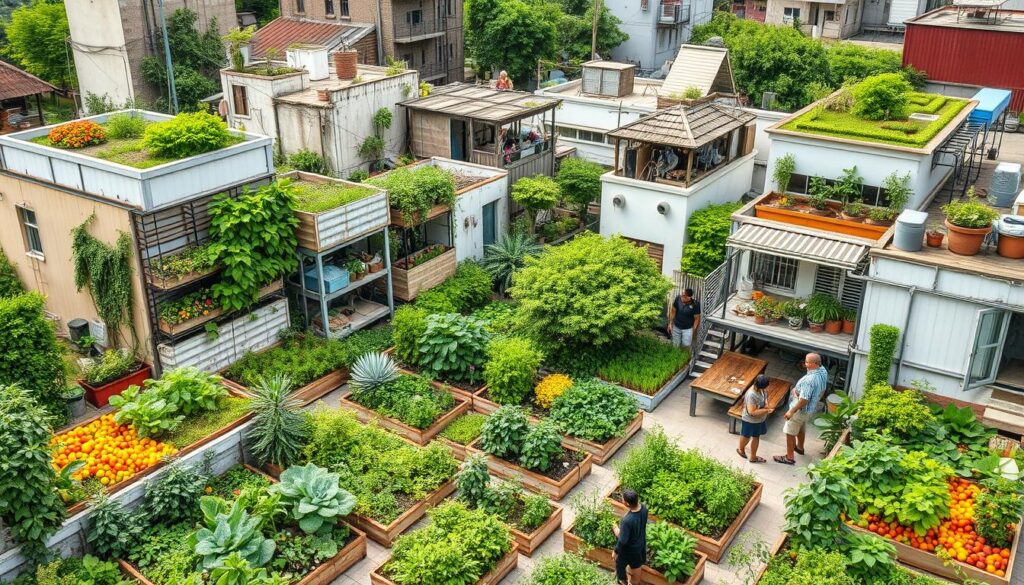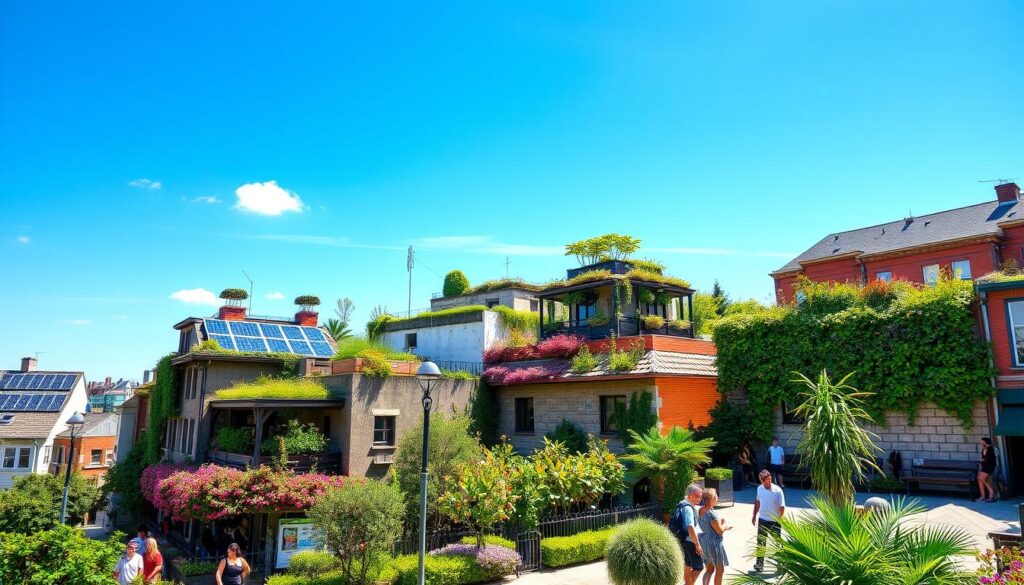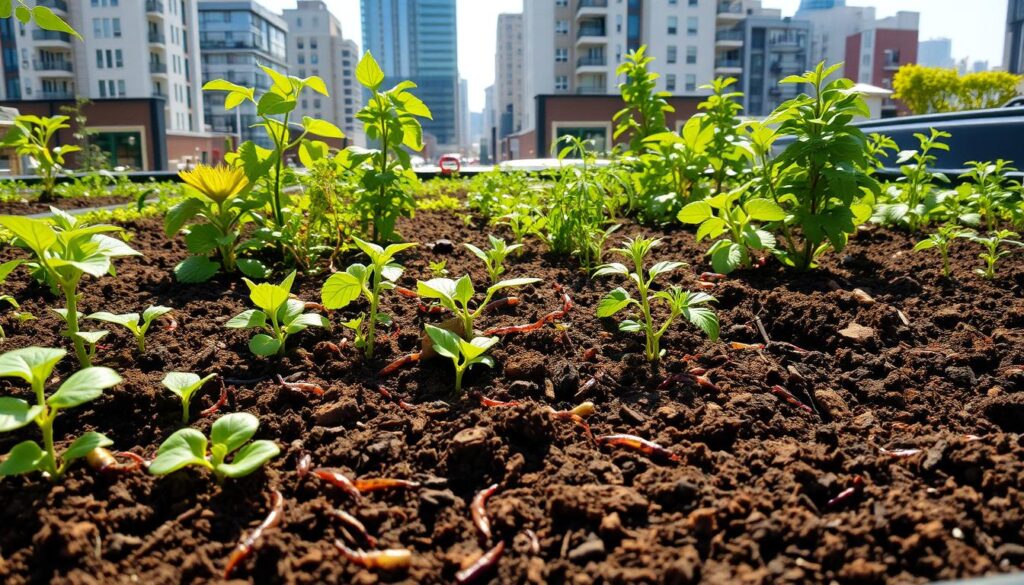More than 55% of people live in cities worldwide. It’s vital to find ways to make cities more sustainable. Permaculture helps by designing cities like nature does. This approach can make cities greener, improve food access, and boost biodiversity.
Permaculture is key in urban planning. Cities are big polluters, producing 70% of carbon dioxide and using 60% of resources. But, if 10% of city folks grew their own food, it could feed everyone. This shows the power of urban farming.
Assessing permaculture infrastructure and evaluating sustainable designs are crucial. Projects like Incredible Edible Todmorden show how. By using empty spaces for gardens and applying permaculture, cities can be greener and more food-secure.
Key Takeaways
- Over 55% of the global population resides in urban areas, emphasizing the need for sustainable design evaluation.
- Permaculture infrastructure assessment is crucial in creating sustainable human environments.
- Urban areas produce approximately 70% of the world’s carbon dioxide emissions, highlighting the need for change.
- If just 10% of urban residents produce food in their own gardens, it could yield sufficient food for everyone.
- Permaculture community groups can start with 10 to 50 individuals and grow to between 200 and 500 participants, demonstrating the potential for community involvement.
- Reports indicate significant carbon emission reductions and enhanced waste management in cities that have implemented permaculture principles.
Understanding Permaculture in Urban Settings
Permaculture is all about working with nature, not against it. It’s about using resources smartly and cutting down on waste. This way, we can create systems that can take care of themselves. In cities, permaculture is key to solving environmental problems.
An ecological site analysis helps us understand the city’s ecosystem. It shows us where we can use permaculture to make a difference. A green building assessment also helps by checking if buildings are eco-friendly.
By using permaculture, cities can lessen their harm to the environment. This makes communities more sustainable. We can do this in many ways, like:
- Creating sustainable urban plans
- Getting people involved in permaculture projects
- Doing ecological site analysis and green building assessment in city planning
When we add permaculture to city planning, we make cities stronger and greener. This way, cities become better places for everyone and the planet.
Benefits of Urban Permaculture
Urban permaculture brings many benefits, like making food more secure and boosting biodiversity. It helps cities lessen their environmental footprint through environmental impact evaluation. This way, cities can build more sustainable food systems. It also helps in regenerative development analysis by supporting local food and cutting down carbon emissions.
Some main advantages of urban permaculture are:
- Enhancing food security through local food production
- Promoting biodiversity by creating green spaces and urban wildlife habitats
- Reducing carbon emissions and mitigating climate change
- Improving air and water quality
Urban permaculture also has social perks, like boosting community ties. People can join community gardens to work on sustainable food systems. This helps in regenerative development analysis by encouraging green practices and cutting down on waste.

In summary, urban permaculture is a complete method for sustainable growth. It tackles both environmental and social challenges. By using environmental impact evaluation and regenerative development analysis in city planning, cities can build more green and strong food systems.
| Benefits of Urban Permaculture | Description |
|---|---|
| Enhancing Food Security | Local food production reduces reliance on industrial agriculture |
| Promoting Biodiversity | Green spaces and urban wildlife habitats support local ecosystems |
| Reducing Carbon Emissions | Sustainable food systems mitigate climate change |
Key Concepts in Urban Adaptation
Urban adaptation in permaculture means making cities strong and green. It’s key today because climate change is affecting us more. A site sustainability audit helps us see where cities can get better. It shows where we need to work harder to be kinder to the planet.
Getting people to work together is also important. David Holmgren, a permaculture founder, says cities are a big part of permaculture. By joining forces, we can make cities better for all living things and fight climate change.
- Resilience: The ability of urban ecosystems to withstand and recover from environmental stresses and shocks.
- Sustainability: The ability of urban ecosystems to maintain their natural resources and functions over time.
- Community involvement: The active participation of community members in the planning and implementation of permaculture projects.
- Collaboration: The cooperation and coordination among different stakeholders, including government agencies, community groups, and private organizations, to achieve common goals.
By using these ideas in city planning, we can make cities better for everyone. A site sustainability audit and permaculture infrastructure assessment guide us. They help us find ways to make cities more green and strong.
Assessing Urban Environments for Permaculture
When looking at urban areas for permaculture, a detailed ecological site analysis is key. This step checks the local ecosystem, like climate, soil, and life, to find the best way to make a green, self-sufficient city spot. A sustainable design evaluation helps spot chances and hurdles, like small spaces or rules.
Understanding what the community needs and has is vital in urban permaculture. This can be done by working with the community. It builds support and ensures the project lasts. Urban permaculture offers many benefits, like:
- More food and fresh produce
- Better biodiversity and ecosystem health
- Stronger community ties

By using permaculture in city planning, cities can become greener, stronger, and better places to live. This is done by combining ecological site analysis and sustainable design evaluation. These steps help find ways to improve and make the city and nature work together better.
| Benefits of Urban Permaculture | Description |
|---|---|
| Food Security | More fresh, local food |
| Biodiversity | Healthier ecosystems and more life |
| Community Engagement | Stronger social bonds and community involvement |
Designing Permaculture Systems in Cities
Creating permaculture systems in cities needs a creative and all-around approach. It’s important to think about the special challenges and chances of urban areas. This means doing a green building assessment to see how the design affects the environment.
By doing this, city gardeners can make sustainable and eco-friendly spaces. These spaces help bring back biodiversity and lessen their environmental impact.
Eco-Friendly Landscape Design
Eco-friendly landscape design is key in city permaculture systems. It includes using native plants, collecting rainwater, and smart irrigation systems. A detailed environmental impact check can show the best design ways for a city area.
Some important things to think about are:
- Using front yards and shared spaces between homes for gardening and food making
- Putting up vertical gardens and container gardens to use space well
- Supporting local trees and green projects to boost urban biodiversity
Vertical Gardening and Space Utilization
Vertical gardening and making the most of space are vital in city permaculture design. By using walls, roofs, and other city spots, gardeners can make productive and green gardens, even in tiny areas. This method helps lessen the environmental effect of city farming, offering many benefits like more food and better air.
Water Management Strategies
Effective water management is key in permaculture, even more so in cities where water is scarce. A regenerative development analysis can spot ways to use water better and cut down on waste. By doing a site sustainability audit, people can figure out how much water they use and find ways to use less.
Some good ways to manage water include collecting rainwater and recycling greywater. Rainwater harvesting can cut down on household water use by half. Greywater recycling can save up to 40% of fresh water. These methods can be used in many ways, such as:
- Installing rainwater harvesting systems to collect and store rainwater for non-potable uses
- Implementing greywater recycling systems to reuse water from sinks, showers, and washing machines
- Using efficient irrigation systems and water-wise landscaping to reduce water usage
By using these strategies, people can use less water and help the planet. As more people move to cities, managing water well will become even more critical.
A site sustainability audit can show where to improve and how to start using water better. It involves checking how much water is used, finding ways to use less, and making a plan to do it. By being proactive about water management, people can lessen their environmental impact and help create a greener future.
| Water Management Strategy | Potential Water Savings |
|---|---|
| Rainwater Harvesting | Up to 50% |
| Greywater Recycling | 30-40% |
| Efficient Irrigation Systems | Up to 30% |
Soil Health in Urban Areas
Soil health is key in urban permaculture. It affects how well urban gardens and farms grow. A permaculture check-up is vital to see how soil is doing and what needs fixing. This helps gardeners and farmers plan better, considering urban soil’s special needs.
To keep soil healthy, using compost, cover crops, and rotating crops is helpful. These methods boost soil’s fertility and structure. They also cut down on the need for harmful chemicals. For instance, Asaṅga uses polyculture to grow food and cover crops together. This makes the soil better and holds more moisture.
When designing sustainably, we must think about soil pollution in cities. Pollutants like heavy metals and pesticides can harm people and the environment. To clean up soil, gardeners and farmers can use plants to absorb these pollutants.

By focusing on soil health and using smart design, urban gardens and farms can thrive. This approach boosts food security, supports biodiversity, and fights the urban heat island effect. It also brings economic and social gains.
| Soil Health Strategies | Benefits |
|---|---|
| Composting | Improves soil fertility and structure |
| Cover cropping | Reduces soil erosion and increases biodiversity |
| Crop rotation | Improves soil fertility and reduces pest and disease pressure |
Urban Wildlife Integration
As the world gets more urban, with over 55% of people living in cities, we must think about wildlife. Urban growth has broken up habitats, threatening urban wildlife. Ecological site analysis helps find places for wildlife to live.
It’s key to create homes for urban wildlife, like pollinators, to keep biodiversity alive. This can be done through green building assessment and using wildlife-friendly practices in permaculture. Some ways to help urban wildlife include:
- Creating green spaces and wildlife-friendly gardens
- Using native plants to support local wildlife
- Designing urban biodiversity corridors to connect wildlife populations
By using these methods, cities can become greener and support local wildlife. For example, New York City’s High Line and Chicago’s Green Alleys show how urban biodiversity projects can help restore habitats and improve ecosystems.
Integrating urban wildlife into permaculture is vital for biodiversity and urban ecosystem health. By focusing on ecological site analysis and green building assessment, we can make cities better for wildlife.
| Strategy | Benefits |
|---|---|
| Creating green spaces | Mitigates urban heat island effect, leads to energy savings, and prevents flooding |
| Implementing native plant species | Supports local wildlife, enhances habitat connectivity, and increases biodiversity |
| Designing urban biodiversity corridors | Connects wildlife populations, boosts genetic diversity, and enhances ecosystem services |
Community Gardens as a Permaculture Strategy
Community gardens are key in permaculture, offering many benefits to urban areas. They help reduce environmental impact and support sustainable growth. This makes them essential for creating green spaces.
These gardens bring people together, improve food access, and boost biodiversity. Key benefits include:
- Increased access to fresh, healthy produce
- Community building and social connections
- Opportunities for education and skill-building
- Enhanced mental and physical well-being
By using permaculture, community gardens can lead in sustainable urban growth. They can manage resources better, cut down on waste, and foster ecosystems. This makes them crucial for environmental and community health.
Supporting community gardens helps build a better food system. They can change urban areas for the better through environmental and social impact. This is a powerful way to make a difference.
| Benefits of Community Gardens | Percentage of Community Gardens |
|---|---|
| Increased access to fresh produce | 40% |
| Community building and social connections | 60% |
| Opportunities for education and skill-building | 50% |
Educational Initiatives in Urban Permaculture
Urban permaculture projects boost local biodiversity and food security. Over 25% of locals benefit from community gardens. Educational efforts are key to spreading awareness and skills.
A site sustainability audit finds areas for betterment. A permaculture infrastructure assessment guides in designing sustainable systems.
Workshops and skill-building programs teach community members about permaculture. The Permaculture Education Institute has thousands of free articles and over 125,000 YouTube subscribers. The Ethos Foundation and Permayouth offer free education to refugees, youth, and women in East Africa.
Engaging Local Schools and Groups
Engaging local schools and groups is vital for urban permaculture success. Partnerships with local organizations and groups expand the initiative’s reach. This fosters community and collaboration.
Hands-on involvement in urban permaculture projects boosts problem-solving and critical thinking by 60%. A permaculture infrastructure assessment finds ways to engage the community.
Some key statistics show the impact of educational initiatives in urban permaculture:
- Over 2500 registrants joined the first International Permaculture Festival of Ideas.
- 67% of urban permaculture project participants feel more connected to their community.
- 85% of those in experiential learning programs keep new skills and knowledge.
- 90% of participants feel empowered and responsible for community and environmental issues.
A site sustainability audit and permaculture infrastructure assessment guide educational initiatives. They ensure these efforts promote sustainable practices and community engagement.
Policy and Urban Planning for Permaculture
Effective policy and urban planning are key for permaculture in cities. They involve a sustainable design evaluation to check if permaculture projects work. This ensures they follow city rules. This way, cities can help permaculture grow, making them more sustainable and strong.
An ecological site analysis is vital to see a site’s permaculture potential. It looks at climate, soil, and resources. This helps design systems that fit the site’s needs. Cities can then support sustainable growth and lessen their environmental impact.
Green roofs, rainwater systems, and community gardens are great examples. They offer ecological benefits and help communities socially and economically. As cities expand, using permaculture in planning becomes even more important.
Supporting permaculture and sustainable design helps cities towards a greener future. It needs teamwork from policymakers, planners, and the community. Together, they can make spaces that support permaculture and benefit both people and the planet.
Challenges in Urban Permaculture Adaptation
Urban permaculture faces big challenges like limited space and economic issues. To tackle these, we need to do a green building assessment. This helps us see how urban growth affects the environment. It shows us where we can use permaculture to lessen the environmental impact evaluation of cities.
A study on urban agriculture and sustainability shows we need flexible models. These models must think about both economic and environmental factors in cities. The study also stresses the value of getting the community involved in permaculture projects.
Some ways to beat these challenges include:
* Using creative designs like vertical gardens to make the most of space
* Getting the community involved in permaculture projects
* Doing a detailed environmental impact evaluation to find places for permaculture
* Using green building assessment to lessen the environmental harm of city growth
By tackling these issues and using smart strategies, we can make cities more sustainable and strong.
Measuring Success in Urban Permaculture
Urban permaculture projects need to be checked to see how well they’re doing. A regenerative development analysis helps figure out the project’s environmental and community impact. It looks at things like energy use, water saving, and cutting down waste.
A site sustainability audit is also key. It checks if the project is good for the environment, people, and the economy. Regular audits help urban permaculture folks spot what needs work and make better choices.
Indicators of Sustainable Practices
Some important signs of sustainable practices in urban permaculture are:
- Energy efficiency
- Water conservation
- Waste reduction
- Biodiversity conservation
- Community engagement and participation
Community Feedback and Evaluation
Getting feedback from the community is vital. It helps find out what needs to get better and make changes. This feedback also builds trust and support, helping the project last longer.
Future Trends in Urban Permaculture
The world is getting more crowded, making sustainable living in cities key. Urban permaculture is looking bright, with new ways to grow food and use tech.
Innovations in Sustainable Urban Agriculture
New farming methods like vertical gardens and hydroponics are changing city food production. These methods use space well, save resources, and are kinder to the planet. By using permaculture, city farmers can build systems that work like nature, improving food and biodiversity.
The Role of Technology in Permaculture
Technology is set to be a big part of urban permaculture’s future.Permaculture infrastructure assessmentandsustainable design evaluationtools will guide us. Apps and systems that track soil and water will change how we manage urban farms.
Permaculture in cities is a big hope for our planet. With new ideas and tech, we can make cities better. They can be greener, fairer, and more self-sufficient, leading to a brighter future.

